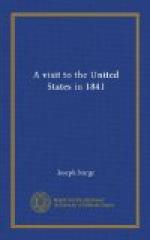“Jose Ruiz, is a very gentlemanly and intelligent young man, and speaks English fluently. He was the owner of most of the slaves and cargo, which he was conveying to his estate on the Island of Cuba. The other, Pedro Montez, is about fifty years of age, and is the owner of three of the slaves. He was formerly a ship master, and has navigated the vessel since her seizure by the blacks. Both of them, as may be naturally supposed, are most unfeignedly thankful for their deliverance. Pedro is the most striking instance of complacency and unalloyed delight we have ever witnessed, and it is not strange, since only yesterday his sentence was pronounced by the chief of the bucaneers, and his death song chanted by the grim crew, who gathered with uplifted sabres around his devoted head, which, as well as his arms, bear the scars of several wounds inflicted at the time of the murder of the ill-fated captain and crew. He sat smoking his Havana on the deck, and to judge from the martyr-like serenity of his countenance, his emotions are such as rarely stir the heart of man. When Mr. Porter, the prize master, assured him of his safety, he threw his arms around his neck, while gushing tears coursing down his furrowed cheek, bespoke the overflowing transport of his soul. Every now and then he clasped his hands, and with uplifted eyes, gave thanks to ‘the Holy Virgin’ who had led him out of his troubles.”
It will be necessary to contrast the deeds of these “gentlemanly and intelligent” Christians with that of the “ruthless gang of African bucaneers,” from whose grasp they were so providentially rescued. In giving the subsequent detail, I would not be understood as compromising for a single instant my belief in the inviolability of human life, though it must I think be confessed that in the instance related below, the heathen and barbarous negroes contrast very favorably with the civilized and Christian Spaniards.
“The following communication from Mr. Day, of New Haven, gives a summary account of the African captives, as stated by themselves, from the time they left Africa, till the time they obtained possession of the Amistad:
“NEW HAVEN, OCT. 8, 1839.
[To the Editor of the Journal of Commerce.]
“Gentlemen—The following short and plain narrative of one or two of the African captives, in whose history and prospects such anxious interest is felt, has been taken at the earliest opportunity possible, consistently with more important examinations. It may be stated in general terms, as the result of the investigations thus far made, that the Africans all testify that they left Africa about six months since; were landed under cover of the night at a small village or hamlet near Havana, and after ten or twelve days were taken through Havana by night by the man who had bought them, named Pipi, who has since been satisfactorily proved to be Ruiz; were cruelly treated on the




